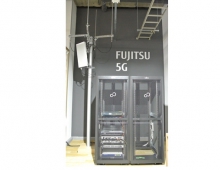
Fujitsu Develops Technology Enabling Prolonged Viewing of Digital Terrestrial Broadcasts on Mobile Phones
Fujitsu Limited announced the development of a low-power analog to-digital (AD) converter that employs a delta-sigma(*1) modulator for mobile phones that are capable of receiving digital terrestrial television and radio broadcasts(*2).
The new delta-sigma modulator-based AD converter can reduce power consumption levels of tuners embedded in mobile phones to 30 milliwatts (mW), approximately one-sixth to one-third the power drain of current levels, thereby enabling prolonged viewing of terrestrial digital broadcasting on mobile phones by significantly lessening the power consumption of mobile phone batteries. In addition, the integration of the new AD converter with OFDM demodulator (*3) onto a single chip is expected to facilitate the development of mobile phones that are more compact than currently available.
Fujitsu will present details of this new AD converter and its accompanying technologies at the 2005 IEEE International Solid-State Circuit Conference which started on February 6 in San Francisco.
Research for these developments has been supported by the National Institute for Information and Communications Technology (NICT), an incorporated administrative agency of the Japanese government.
[Background]
Digital terrestrial television broadcasting began in Japan in December 2003, and broadcasts for mobile phone reception ("1-segment broadcasts") are scheduled to start at the end of 2005. Digitization of terrestrial radio broadcasting, for which test broadcasting began in Japan October 2003, is also expected to begin in the near future.
[Technological Challenges]
In order to view or listen to digital terrestrial television or radio broadcasts on mobile phones for prolonged periods of time, the tuners and OFDM demodulators of the phone must be able to operate with low power consumption, to allow extended battery operation. The components of a tuner that demand the most power are the analog channel-selection filter and the high-frequency RF (radio frequency) amplifier. By replacing the analog filter with a low-power digital channel-selection filter and incorporating part of the high-frequency amplifier's variable-gain function (*4) into the AD converter, it is possible to significantly lower the power demand for the tuner. However, replacing the analog filter with a digital filter requires a very precise converter. In addition, in order for the AD converter to incorporate the variable-gain function, it must have an amplifier circuit, which leads to increased power consumption within the AD converter.
[Newly Developed Technology]
Fujitsu has succeeded in developing a low-power delta-sigma AD converter which enables prolonged viewing of digital terrestrial broadcasts on mobile phones. The converter was designed using Fujitsu's 0.11 micrometer CMOS technology.
Key features of the new delta-sigma AD converter are as follows:
- Wide dynamic range (*5) achieved with delta-sigma modulators
Fujitsu's new converter and technology represent the world's first use of a delta-sigma AD converter for digital terrestrial broadcasts. Delta-sigma modulators provide a wide dynamic range and heighten the precision of the converter. - Power reduction achieved with a variable scale
A delta-sigma AD converter with variable scale was developed, enabling the converter to have a variable-gain function without increasing its power consumption. - New phase-compensation circuit reduces power demands
In delta-sigma AD converters, phase-compensation (*6) is necessary to maintain stable operation. Fujitsu developed a new phase-compensation method utilizing capacitors and resistors, and succeeded in reducing the number of amplifiers in the converter by half, thereby achieving lower power consumption.
[Results]
Fujitsu achieved low power consumption of just 3.5mW during 1.2V operation with the new delta-sigma AD converter. This makes it possible to reduce the power consumption of tuners being developed for terrestrial digital broadcasting with consumption levels of 100 to 200mW, to 30mW, enabling such broadcasting to be viewed over prolonged periods of time. In addition, by integrating this AD converter and an OFDM demodulator into a single chip, it is anticipated that mobile phones can become further compact.
[Future Developments]
Fujitsu intends to commercialize within a year a compact, low-power tuner incorporating its new delta-sigma AD converter.
From JCNNetwork





















